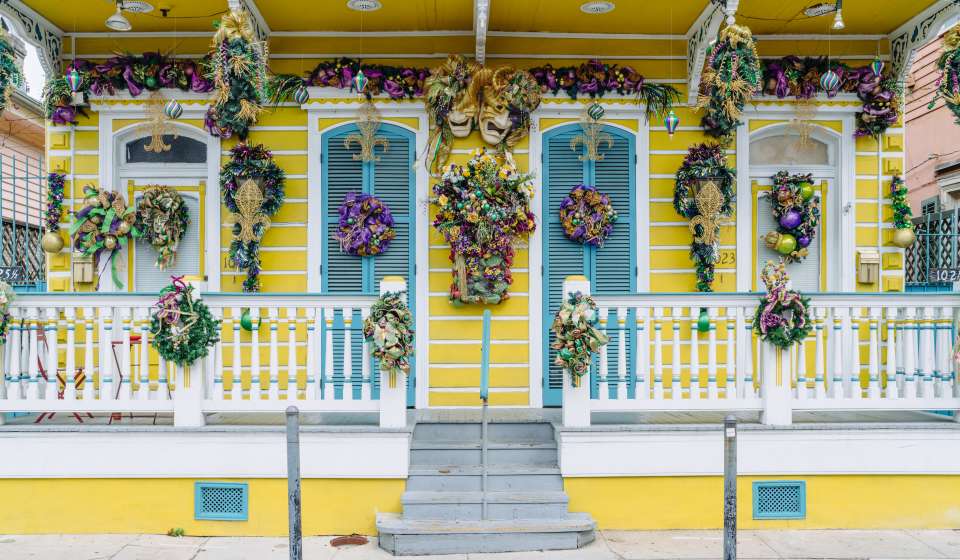
-
Wedding Tools
- Complimentary Planning Assistance
- Destination Wedding Guide Digital Copy
- Elopement Packages
- Marriage License & Legal Essentials
- Checklist
- Welcome Bag Ideas
- Second Lines
- The History of Wedding Umbrellas and More in New Orleans
- Wedding Cake Pulls
- Destination Wedding Guide Printed Copy
- Wedding Inspiration
-
Venues
-
Vendors
-
Pre & Post Wedding
- Wedding Inspiration
- Contact Us
-
Why New Orleans Is Built To Host
- Hotels
-
Meeting & Event Venues
-
Services & Planning Tools
-
Group PR & Marketing Tools
- Convention Calendar
- Testimonials
- Awards
-
Online RFP
- Availability Grid
- Contact Us
-
Things to Do
-
Eat
-
Drink
-
Stay
- Book a New Orleans Hotel
- Hotel Directory
- Bed And Breakfasts: Hotels - New Orleans & Company
-
Places To Stay: New Orleans Hotels - New Orleans & Company
- Saint Charles Avenue Hotels
- Luxury Hotels
- Garden District Hotels
- French Quarter Hotels and Lodging
- Downtown/Central Business District Hotels and Lodging
- Bourbon Street Hotels
- Green Hotels
- Bourbon Street Balcony Hotels - New Orleans & Company
- Haunted Hotels in New Orleans
- Pet-Friendly Hotels
- Historic Hotels
-
Calendar
-
Trip Planning Tools
- Insider's Blog
- LOVENOLA.TV 24/7 Broadcast
-
Weddings
-
Wedding Tools
- Complimentary Planning Assistance
- Destination Wedding Guide Digital Copy
- Elopement Packages
- Marriage License & Legal Essentials
- Checklist
- Welcome Bag Ideas
- Second Lines
- The History of Wedding Umbrellas and More in New Orleans
- Wedding Cake Pulls
- Destination Wedding Guide Printed Copy
- Wedding Inspiration
-
Venues
-
Vendors
-
Pre & Post Wedding
- Wedding Inspiration
- Contact Us
-
Wedding Tools
-
Meeting Planners
-
Why New Orleans Is Built To Host
- Hotels
-
Meeting & Event Venues
-
Services & Planning Tools
-
Group PR & Marketing Tools
- Convention Calendar
- Testimonials
- Awards
-
Online RFP
- Availability Grid
- Contact Us
-
Why New Orleans Is Built To Host
-
Groups
-
Travel Professionals
-
Membership
-
Press and Media
- Community


ALL ABOUT MARDI GRAS
The more you know about Mardi Gras tradition, the more fun you’ll have. Here’s a primer based on facts from Mardi Gras guru Arthur Hardy.
When Is Mardi Gras?
Mardi Gras or Fat Tuesday is always 47 days before Easter. Carnival season begins on Jan. 6, Twelfth Night, the Christian holy day of the Epiphany, and ends with Mardi Gras. It's a celebration of life that precedes the fasting and simple living during the Christian season of Lent. Because Easter is variable, Mardi Gras can be any Tuesday between Feb. 3 and March 9 and so the length of Carnival fluctuates accordingly.
Number of Parades
During the 12-day period leading up to Mardi Gras, nearly 70 parades roll in the area. An 18-float procession of a 450-member krewe can feature more than 75 units. When you add band members, dance groups, clowns and motorcycle squadrons, the number of participants often totals more than 3,000.
Masking
Masks were first worn during Mardi Gras so wearers could escape society and class constraints. When wearing a mask, carnival goers were free to mingle with whatever class they desired and keep their reputation untarnished.
Today, wearing masks during Mardi Gras is tradition. Float riders are required to wear masks by law in keeping with the mystery and tradition, and many krewes never reveal who their king or queen is.
Mardi Gras Colors
In 1872, Rex, the king of Carnival, proclaimed the official colors of Mardi Gras to be purple, green and gold. While Arthur Hardy believes they were probably chosen simply because they looked good together, Rex assigned a meaning to the colors in his 1892 parade titled Symbolism of Colors: Purple represents justice, green stands for faith, and gold signifies power.
Carnival Krewes
Carnival clubs are chartered as non-profit entities. They are financed by dues, by the sale of merchandise to the members and by fund-raising projects. Most krewes are also actively involved in charitable work. Some are all female, others all male and families belong for many generations. The krewe throws the parade but not every member participates in the parade.
Parade Themes
Nearly 2,000 Mardi Gras parades have rolled since 1857. Their themes have been taken from history, children's stories, legends, geography, famous people, entertainment, mythology and literature. Some of the most popular parades are known for their satire and political comedy. All the floats are decorated to fit the theme and every year the krewe picks a new theme.
Throws
According to Arthur Hardy, items have been tossed off floats since at least 1871, when a masker costumed as Santa Claus aboard float No. 24 in the Twelfth Night Revelers parade dispensed gifts to the crowd. Along with beads, toys, cups and doubloons (colorful aluminum coins stamped with the parade organization and theme), many krewes have signature throws -- Zulu has its coconut, for instance, and Muses throws shoes. Plus, some krewes have upped the game with fiber optics and blinking LEDs while others are going more traditional with glass beads.
Visit www.mardigrasguide.com for more information.













